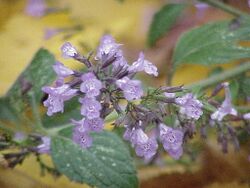Biology:Calamintha
| Calamintha | |
|---|---|

| |
| Calamintha grandiflora | |
| Scientific classification | |
| Kingdom: | Plantae
|
| (unranked): | |
| (unranked): | |
| (unranked): | |
| Order: | |
| Family: | |
| Genus: | Calamintha Mill.
|
Calamintha is a genus of plants that belongs to the family Lamiaceae. Commonly called the calamints, there are about eight species in the genus (around 30 before revisions in taxonomy) which is native to the northern temperate regions of Europe, Asia and America.
Calamintha species are used as food plants by the larvae of some Lepidoptera species including Coleophora albitarsella.
Species
- Calamintha ashei
- Calamintha baumgarteni
- Calamintha caerulescens
- Calamintha coccinea
- Calamintha dentata
- Calamintha grandiflora - large-flowered calamint, an ornamental plant.
- Calamintha incana
- Calamintha nepeta
- Calamintha sylvatica - common calamint, a low-growing plant with a minty smell and lavender flowers. It prefers alkaline soil. The leaves can be used to make tea.
Moved to genus Acinos
- Acinos alpinus (formerly Calamintha alpina) - the alpine calamint
- Acinos arvensis (formerly Calamintha acinos) - also called basil thyme
- Acinos rotundifolius (formerly Calamintha exigua and Calamintha graveolens)
Moved to genus Clinopodium
- Clinopodium chinense (formerly Calamintha chinensis)
- Clinopodium nepeta (formerly Calamintha nepeta or Calamintha officinalis) - lesser calamint
- Clinopodium umbrosum (formerly Calamintha umbrosa)
- Clinopodium vulgare (formerly Calamintha vulgaris or Calamintha clinopodium) - the wild basil
Uses
Calamintha species are used in the popular Middle Eastern culinary blend called za'atar. Za'atar is a general name for any Middle Eastern herb from the genera Origanum (oregano), Calamintha (calamint), Thymus (thyme) and Satureja (savory). It is also the name for a condiment made from the dried herb(s), mixed together with sesame seeds, dried sumac, often salt, and other spices. According to Nissim Krispil, an ethno-botanist and folklore researcher, Calamintha incana infusions aid the birthing women (and those with uterus problems).[1]
References
- ↑ Krispil, Nissim (2000). המדריך השלם לצמחי מרפא בארץ ובעולם. Maariv Publishing. p. 125. https://simania.co.il/bookdetails.php?item_id=33335.
External links
Wikidata ☰ Q820063 entry

